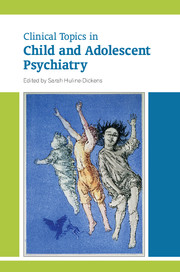Book contents
- Frontmatter
- Contents
- List of tables
- List of boxes
- List of figures
- List of contributors
- Preface
- 1 Child psychiatry and the people who have shaped it
- 2 Fabrication and induction of illness in children
- 3 Personality disorders as disorganisation of attachment and affect regulation
- 4 Post-traumatic stress disorder and attachment: possible links with borderline personality disorder
- 5 Management of antisocial behaviour in childhood
- 6 Pharmacology for attention-deficit hyperactivity disorder, Tourette syndrome and autism spectrum disorder
- 7 Pharmacology for anxiety and obsessive–compulsive disorders, affective disorders and schizophrenia
- 8 Pharmacological management of core and comorbid symptoms in autism spectrum disorder
- 9 Pharmacological treatment of depression and bipolar disorder
- 10 Cognitive–behavioural therapy with children, young people and families: from individual to systemic therapy
- 11 Anxiety disorders
- 12 Somatising: clinical presentations and aetiological factors
- 13 Somatising: management and outcomes
- 14 Evaluating psychological treatments for children with autism
- 15 Attention-deficit hyperactivity disorder: assessment and treatment
- 16 Schizophrenia
- 17 Tourette syndrome
- 18 Sleep disorders
- 19 Self-harm in adolescents
- 20 Adolescent substance misuse: an update on behaviours and treatments
- 21 Eating disorders
- 22 Gender dysphoria in young people
- 23 The psychiatry of children aged 0–4
- Index
4 - Post-traumatic stress disorder and attachment: possible links with borderline personality disorder
Published online by Cambridge University Press: 02 January 2018
- Frontmatter
- Contents
- List of tables
- List of boxes
- List of figures
- List of contributors
- Preface
- 1 Child psychiatry and the people who have shaped it
- 2 Fabrication and induction of illness in children
- 3 Personality disorders as disorganisation of attachment and affect regulation
- 4 Post-traumatic stress disorder and attachment: possible links with borderline personality disorder
- 5 Management of antisocial behaviour in childhood
- 6 Pharmacology for attention-deficit hyperactivity disorder, Tourette syndrome and autism spectrum disorder
- 7 Pharmacology for anxiety and obsessive–compulsive disorders, affective disorders and schizophrenia
- 8 Pharmacological management of core and comorbid symptoms in autism spectrum disorder
- 9 Pharmacological treatment of depression and bipolar disorder
- 10 Cognitive–behavioural therapy with children, young people and families: from individual to systemic therapy
- 11 Anxiety disorders
- 12 Somatising: clinical presentations and aetiological factors
- 13 Somatising: management and outcomes
- 14 Evaluating psychological treatments for children with autism
- 15 Attention-deficit hyperactivity disorder: assessment and treatment
- 16 Schizophrenia
- 17 Tourette syndrome
- 18 Sleep disorders
- 19 Self-harm in adolescents
- 20 Adolescent substance misuse: an update on behaviours and treatments
- 21 Eating disorders
- 22 Gender dysphoria in young people
- 23 The psychiatry of children aged 0–4
- Index
Summary
This chapter principally concerns the relationship between trauma, attachment and the emergence of personality disorder. Clearly, whether or not young people should be given a diagnosis of personality disorder is an area of controversy. As explained by Sarkar & Adshead in Chapter 3, personality disorders can be viewed as developmental conditions that begin in childhood and adolescence. Some clinicians prefer to use diagnoses that emphasise trauma rather than challenging behaviours, and in this chapter I will use the term complex post-traumatic stress disorder (complex PTSD) instead of the possible alternative of emerging borderline personality disorder.
Owing to the reluctance of clinicians to diagnose personality disorders in young people, there is little established research evidence on effective treatments for that age group. Consequently, much of this chapter relates to adults. However, it gives an understanding of how abuse in childhood can lead to this complex condition, and it may be of relevance to older adolescents and indeed to the parents (especially mothers) of children presenting to child and adolescent mental health services.
In both ICD-10 (World Health Organization, 1992) and DSM-5 (American Psychiatric Association, 2013), the diagnostic criteria for PTSD require that the individual has been exposed to ‘a stressful event or situation of exceptionally threatening or catastrophic nature’ (according to ICD-10) which may elicit ‘fear-based re-experiencing, emotional, and behavioural symptoms’ (according to DSM-5). Research shows that the events resulting in most diagnoses of PTSD are actually quite common and that none of these traumas is so powerful that exposure typically leads to PTSD (Kessler et al, 1999: p. 55). The disorder is more frequent and severe in victims of man-made rather than natural disasters because of the meaning that can be attributed to the former (Lifton & Olson, 1976: pp. 10–14), and is less likely to occur in well-integrated communities than in fragmented ones (Quarantelli, 1985: p. 192). These findings tie in with the main conclusion of treatment guidelines published by the National Institute for Health and Care Excellence (NICE), which singles out the lack of social support as the most important risk factor for PTSD (National Collaborating Centre for Mental Health, 2005: p. 94).
- Type
- Chapter
- Information
- Clinical Topics in Child and Adolescent Psychiatry , pp. 41 - 56Publisher: Royal College of PsychiatristsPrint publication year: 2014



